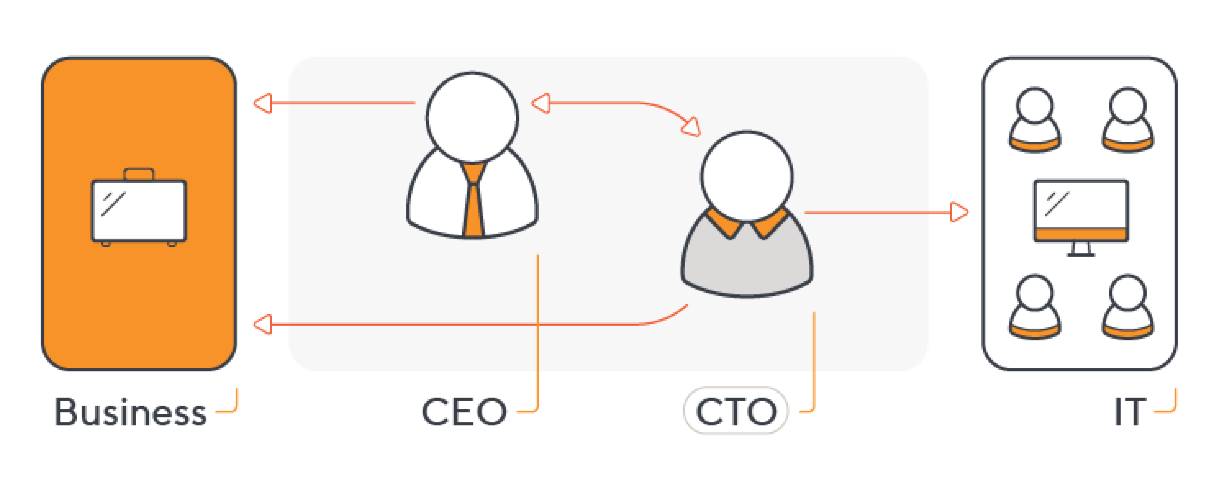‘Chief Technical Officer’ could sound glamorous to some. In reality, it is one of the most important titles in a startup. The smaller the startup the importance the CTO shares with the CEO with regards to leadership. The title is comparatively more exclusive at large enterprises.
A startup’s success is dependant on a reliable CTO to put on multiple hats. The CTO must also be responsible for activities beyond engineering and coding. They need to collaborate with various departments through the company as well as work in the public arena. This diverse role can involve a complex set of tasks and can be organized into a few basic responsibilities described below.
A simple survey will reveal that the CTO or VP of technology at larger enterprises is very different from the same job at a startup. The simple fact is that in a startup you get to hire developers and IT individuals who do specific tasks, architect projects, work on many languages though filling in the gaps is still important. That will almost always fall on the CTO. So instead of just overseeing large picture technology or strategic partnerships, startups CTOs carry out almost everything.
Here are a few things a startup CTO requires to do for the startup to be successful:
1. Building a Minimum Viable Product
Majority of the startup ecosystem want a technical co-founder to build their MFP. Creating the first iteration of the startup’s product will fall on the CTO. This makes lots of corporate CTOs really ineffective for the job. Large enterprise CTOs are usually 2-3 levels of management away from daily engineering,
2. Hiring IT professionals and data managers
Spotting and bringing on engineering talent has to be one of the hardest things tech startup must do now. The job market is not optimum currently for employers and hiring for cultural fit can be a challenge for people used to working in silos as programmers.
3. Sorting out enterprise security
Very few CTOs have implemented security policies. However, when partners choose to see a startup’s security policy at the risk of ending a partnership, standards must be upheld. Minus established standards plenty of startups’ security systems will be non-existent. This usually falls on the CTO to shape up things.
Worried about your website security? check our partner blog to fix it in less than 15 mins.
4. Employee retention
Tech employees will have plenty of options. It is extremely rare holding on to your tech team partners for over 2 years. This usually means that as your startup moves away from the ‘tiny startup’ identity and becomes mid-sized, it is likely your CTO starts dealing with churn. First-time employees seek the excitement of the first months immediately and start seeking new challenges once this runs out. Or founding their own companies. The CTO must begin building the talent pipeline on his own while minimizing turnover.
5. Team growth management
Managing growth at big companies versus those at startups is varied and difficult. In the beginning, you could excite employees through exciting projects with technical challenges. These days you need to attract a lot more specialized individuals with career advancement options, vacation days and benefits. Growth management with 100 employees is very different compared to growth management with 5.
6. Bug testing and eradication
The more a startup grows, the more the demand rises for a low-wage customer service person. Bug management comes into play when such low-wage employees find bugs. It falls on the CTO to tackle such bugs with his team.
7. QA checks
Startups at an early stage rarely have a dedicated QA team or QA person. The smaller companies tend to come up with a system of splitting testing and validation between developers. However, that system is laid out and created by the CTO. This is the form of tedious work that the majority of corporate CTOs have long since past gotten rid of. Hence the added challenge of landing a good CTO at a startup.
8. Vendor relationships
Our world is driven by APIs. At least the world in which developers exist. Many can’t remember the last time they constructed a project that did not connect to two or more third-party services such as Cloud SQL servers or Google Analytics. As a developer, it’s great having such power in your hands. However, as a CTO it becomes very difficult to manage. You must know who is updating which libraries, the plan you signed up for and the one with access to all the secret keys.
9. Overseeing updated enterprise versions
In a startup’s lifetime, there comes a point when you would need to rebuild the MVP which by now has likely been stretched far past its initial use case. Unless your startup grows extremely fast or you have pushed this step off for a very long time, it falls on your CTO to be doing the majority of the planning work on this too. Further stating his role will be much different than it will be during the MVP time, now the CTO will have to manage a team of people instead of building it all himself.
10. Team growth involvement
One of the most prominent reasons startup CTOs are almost never the same people as big company CTOs is the growth management of the tech team and the difficulty involved. At the start, you may excite your employees through the offering of cool projects associated with plenty of technical challenges. Now you must attract a lot more specialized individuals using benefits and advancement opportunities.
11. Application architecture
MVP hardly ever contain high-level architecture work. However, when the time comes to plan the startup version’s next step, the company almost never has the luxury of hiring professional application architects. Here the CTO needs to step in and handle the situation.
Such challenges exist as being far from the only ones that early startup CTOs come into contact with. However, they tend to be some of the biggest issues holding back startups. Especially for those with coding strength. Let us know in the comments below if a CTO fills another role at your company.


 Start using ZapInventory today
Start using ZapInventory today

1 Comment